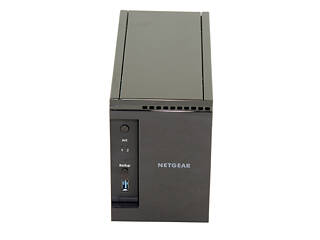 3
3
Netgear ReadyNAS 202 Review
Specifications »Introduction

We would like to thank Netgear for supplying the review sample.

This is the first time we get to evaluate a Netgear NAS, and the main subject of today's review will be a member of the fresh ReadyNAS 200 line. Both the ReadyNAS 202 and 204 use a dual-core ARM Cortex A15 CPU clocked at 1.4 GHz, and not only do both come with an unusually high amount of RAM for a home NAS, but two Gigabit Ethernet ports for either more reliability or faster network transfer speeds, which depends on their mode of operation. That said, the ReadyNAS 202's most important feature isn't its hardware, but its file system. Contrary to most NAS servers that use EXT4, Net-gear's offering uses Btrfs, or B-tree.
Before we start covering the advantages of Btrfs, we had better take a look at what a file system actually does. A file system essentially controls how data is stored and retrieved. It, in other words, provides a way to separate and identify chunks of data. All information inside a storage area is a large body of data without a file system, which would make finding and retrieving a specific piece of data impossible. There are many different file systems today, each with its own advantages that are due to its logic of operation. File systems use metadata, data whose purpose it is to describe some crucial features of specific pieces of data, like creation date, modification date, file size, etc., to properly store and retrieve files.
The ext4 journaling file system is currently the most popular for Linux distributions; however, during the past years, some other file systems with more capabilities an end-user can tap into have emerged. One of these is Btrfs, a copy-on-write filesystem, "COW" for short, with support for a maximum file size of 16 EiB instead of the 1 EiB in ext4. Btrfs also includes other features like snapshots, pooling, and checksums. One of the key features of Btrfs is snapshot, a special type of subvolume that doesn't make copies of files but shares the data and metadata of the subvolume, which makes it very fast and takes very little space. In Btrfs, subvolumes don't have fixed sizes. Their space is dynamically allocated from the storage pool according to the data that is added or removed. Subvolume creation is also pretty easy, and a subvolume can even have nested subvolumes. There is by default always a top-level subvolume, and it is mounted with all of its own subvolumes, but you can change the default subvolume to allow for a specific subvolume to be mounted without having to mount the subvolume that contains it.
Feb 24th, 2025 04:44 EST
change timezone
Latest GPU Drivers
New Forum Posts
- RDNA4 Prediction Time Part Deux!!! (40)
- Why is coil whine still a nuisance? (28)
- Solidigm NVMe Custom Modded Driver for All NVMe Brands SSDs & Any NVMe SSDs (206)
- TPU's Nostalgic Hardware Club (19993)
- The TPU UK Clubhouse (25768)
- Post your Speedtest.net Speeds! (2346)
- Nvidia's GPU market share hits 90% in Q4 2024 (gets closer to full monopoly) (531)
- Authenticode fails for GPU-Z 2.63.0 (1)
- RTX 5090 - Incorrect GPU-Z Clocks, when Overclocking with the Curve Tuner (8)
- [Intel AX1xx/AX2xx/AX4xx/AX16xx/BE2xx/BE17xx] Intel Modded Wi-Fi Driver with Intel® Killer™ Features (275)
Popular Reviews
- ASUS GeForce RTX 5070 Ti TUF OC Review
- MSI GeForce RTX 5070 Ti Ventus 3X OC Review
- darkFlash DY470 Review
- MSI GeForce RTX 5070 Ti Vanguard SOC Review
- MSI GeForce RTX 5070 Ti Gaming Trio OC+ Review
- Galax GeForce RTX 5070 Ti 1-Click OC White Review
- Palit GeForce RTX 5070 Ti GameRock OC Review
- Fantech Aria II Pro Review
- Gigabyte GeForce RTX 5090 Gaming OC Review
- AMD Ryzen 7 9800X3D Review - The Best Gaming Processor
Controversial News Posts
- NVIDIA GeForce RTX 5090 Spotted with Missing ROPs, NVIDIA Confirms the Issue, Multiple Vendors Affected, RTX 5070 Ti, Too (456)
- AMD Radeon 9070 XT Rumored to Outpace RTX 5070 Ti by Almost 15% (304)
- AMD Plans Aggressive Price Competition with Radeon RX 9000 Series (271)
- AMD Radeon RX 9070 and 9070 XT Listed On Amazon - One Buyer Snags a Unit (247)
- Edward Snowden Lashes Out at NVIDIA Over GeForce RTX 50 Pricing And Value (241)
- AMD Denies Radeon RX 9070 XT $899 USD Starting Price Point Rumors (239)
- NVIDIA Investigates GeForce RTX 50 Series "Blackwell" Black Screen and BSOD Issues (234)
- New Leak Reveals NVIDIA RTX 5080 Is Slower Than RTX 4090 (215)
